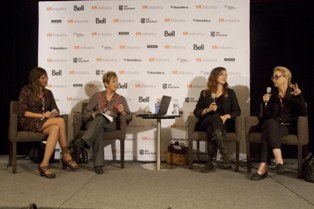TIFF 2011: Costume designers talk characters and challenges

Being a costume designer is more than simply dressing actors, stressed the “From Stitch to Screen: Contemporary Canadian Costume Design” panel on Friday afternoon – it’s about building characters and helping to bring directors’ and producers’ vision to life.
“I’ve seen films fail because actors couldn’t embrace their characters,” said Alex Kavanagh, whose recent credits include Splice and Saw 3D: The Final Chapter.
“[As the costume designer], if you push too far with the actor, you become the enemy. I once put Paris Hilton in a very gothic costume and she said, ‘I would never wear this, but it’s right for my character,’ and that’s when you know an actor gets it.”
Kavanagh was joined by fellow designers Heather Neale (Goon, Keyhole) and Delphine White (Videodrome, Tideland) on the panel moderated by FilmFinders co-founder Sydney Levine.
In order to help directors and producers achieve their desired look and feel, there has to be some give and take with the designers well before the cameras begin to roll, particularly when it comes to the script.
Sounds like simple enough advice, but it’s advice that some filmmakers still don’t always grasp.
“More and more people aren’t sending scripts ahead,” explained White, who says the designer can draw inspiration from lighting direction, setting, the type of cameras being used and the time of year. “We’re starting to get more script treatments instead.”
But, noted Kavanagh, some filmmakers have also been known to change the script after the designer has already come up with initial concepts, which can send all the prep work down the drain.
Heather Neale described the challenges of searching for hockey costumes for Michael Dowse’s comedy Goon, as production was taking place at the height of hockey season.
“We couldn’t find anyone in North America that could do everything all at once and for a decent price, so our most affordable option was to go to China,” explained Neale, who was chosen as the film’s designer because of her prior experience doing costumes for Keep Your Head Up, Kid: The Don Cherry Story.
White said that while hockey uniforms may seem basic, there are many ways to inject character touches into a uniform: “If you look at a police officer on the street, some may wear turtlenecks or ties – that’s a way to bring different aspects to the character’s personality” she said.
Another challenge that all designers and filmmakers should anticipate with costumes is with clearances, added Kavanagh.
“With hockey teams, many names and logos have been copyrighted,” she said. “With Saw, police departments didn’t want their names or logos on any of our uniforms, so we had to create new ones.”
Many of the designers’ costumes are on display at the TIFF Bell Lightbox as part of the Otherworldly: The Art Of Canadian Costume Design exhibit until March 2012.

 The definitive CDN broadcast and production resource.
The definitive CDN broadcast and production resource.










